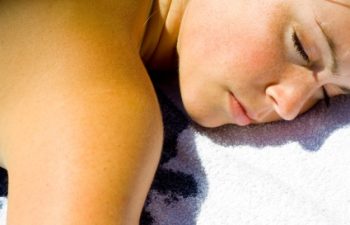It’s the middle of winter. Your skin is extra pale and may even seem blinding. A subtle tan would make you feel and look so much better. What is the harm in a few tanning bed sessions this winter? Not so fast! The lure to have that (temporary) “sun-kissed” complexion to look more attractive in the winter months can be a dangerous trap for your overall health.
Tanning beds are a leading risk factor melanoma skin cancer. Contrary to popular belief, you don’t have to be a “tanning bed addict” to be at risk. In fact, studies show that just one indoor ultraviolet (UV) tanning session increases your chances of developing melanoma by 20 percent, and each additional session during the same year increases the risk by almost another two percent.
Isn’t Indoor Tanning Safer Than Outdoor Tanning?
Many people falsely believe that tanning beds are fairly safe since they don’t involve “real” sun exposure. Tanning beds involve UV exposure and there is no such thing as “safe” UV radiation when it comes to your skin. In fact, tanning beds can be even more harmful, as they deliver a more concentrated form of UV radiation.
In May, 2014, the U.S. Food and Drug Administration (FDA) announced a final order to reclassify ultraviolet (UV) tanning devices from class I (low to moderate risk) to class II (moderate to high risk) devices. All tanning salons should display a warning label to prevent the use of tanning beds for patrons under the age of 18. However, just like cigarettes, it is up to the individual whether or not to heed to these proven dangers and given warnings.
Young Tanners are More at Risk
Teens and young adults can often be the first to deny any long-term consequences of using a tanning bed. A quick tan before a cheer competition or prom can feel like a great reward for your quick and easy tanning bed investment. Unfortunately, the risk of using tanning beds at a young age can come to haunt you later in life. Studies show that those who begin tanning before age 35 increase their risk of developing melanoma by almost 75 percent. Even more alarming, the number of skin cancer cases due to tanning is higher than the number of lung cancer cases due to smoking!
Other Risk Factors for Melanoma
The tanning bed is certainly not the only way you can get skin cancer. In many cases, it is a combination of risk factors that may include one or more of the following:
- White skinned Americans are 20% more likely than African American’s
- Smoking
- Excess sun exposure
- Using tanning beds (UV)
Detecting Skin Cancer Early
Skin cancer is nothing to take lightly. If left alone, skin cancer can be deadly. While you may not be able to erase the time you’ve spent in the tanning bed as a young adult, you can certainly do your part to recognize or detect skin cancer now. At Olansky Dermatology, we recommend annual skin screenings. Early detection is the key to successfully treating skin cancer. Call now to schedule your full body skin check with one of our talented dermatologists.


